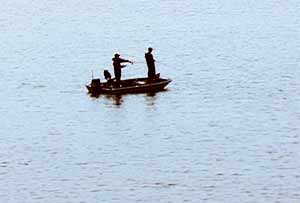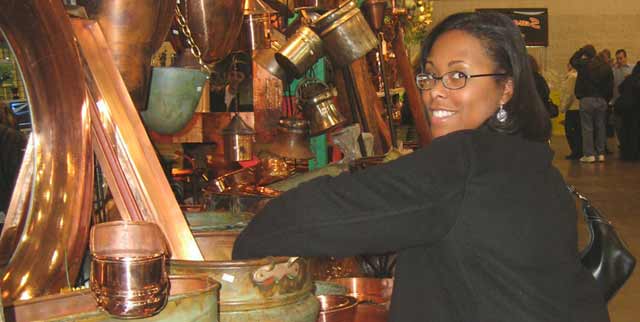Navigating my way around the fish counter
Published: May 1, 2009. One thing I’ve learned about this journey to a more sustainable food lifestyle is that I still have so much to learn. Just when I think I’ve got a good handle on things I discover there is still yet another area where I fall short. First it was bread and now it’s seafood.
When I think about eating Fish or Seafood I often associate it with the summer months there is something about the warm weather that equals seafood for me. I reside a mere 15 minutes away from the Atlantic Ocean so needless to say I usually have access to lots of fresh fish. However, during the colder months I tend not to eat any fish other than canned tuna or the occasional piece of frozen Salmon or Cod and it was after a recent off-season purchase of fresh Salmon that got me thinking about whether or not I was going about my fish purchasing the right way. What types of fish are native to the Atlantic Ocean and is there such a thing as sustainable fishing practices? Quite simply sustainable fishing practices are ones that do not disturb the natural habitat of fish, take scallops for example. My brother in law is a commercial scallop fisherman so that fishing technique is the one that I’m most familiar with. Dive caught is the method that is most sustainable for catching scallops versus dreading a huge net along the bottom of the ocean floor (which is what my brother in law does) disturbing not just the scallops’ natural habitat but the habitat of other fish or seafood in the surrounding areas. Cod, another one of my favorite fish is best when caught using hand line fishing techniques versus some types of netting. The problem with some of these more sustainable fishing practices is like so many other sustainable ways to harvest food, the fisherman is not going to earn the profit that they are looking for. Not too mention that if you are fortunate enough to get dive caught scallops or line caught cod it can be very expensive which is the chief complaint of most citizens when posed with the question of why they don’t buy organic and sustainable food.
Temporarily abandoning my search of looking for dive caught scallops or line caught cod. I decided to find out at the very least what fish/seafood is traditionally harvested along the eastern coastline, and should I even be eating it. But before I continue it has to be said that I was pretty disappointed with the lack of information available on fish/seafood that are more “native” to Southern New Jersey. I also tried to reach out to two local fish merchants that my family has solicited over the years hoping to get their take on the local fishing industry along with a peak at their current inventory and whether the fish was harvested locally and or sustainably. Unfortunately they were unavailable for comment. Based on the information that I was able to find, the following fish should be readily available in my area Blue crab, weakfish, scallops, porgy, monkfish, flounder, catfish, red herring, black sea bass, various types of clams, mackerel, lobster, whiting, and croaker. With the help of the Monterey Bay Aquarium Seafood Watch and the Marine Conservation Society I decided to create my own little cheat sheet to assist me with my future fish purchases.
Blue Crab: Wild-caught is best, commercially harvested using traps, low mercury. Stone crab which is readily available in Southern New Jersey is also an excellent choice.
Weakfish (Sea Trout): Wild-caught is best, commercially fished using line caught method; don’t eat fresh during spawning season October through January.
Scallops: Wild-caught and dive caught is best, commercially fished using nets.
Porgy: Wild-caught is best, commercially fished using trawl nets, low mercury.
Monkfish: Wild-caught is best, commercially fished using trawl method, should be avoided until further notice due to population decline related to fishing technique.
Flounder: Wild-caught is best, commercially harvested, at the moment Flounder should be avoided due to over fishing and high levels of PCBs(PDF).
Catfish: Farmed is the best choice because of sustainable farming practices.
Atlantic Herring: Wild-caught is best, Herring is commercially fished during the months of May-October in the gulf of Maine, and there have been some recent concerns about over fishing.
Black Sea Bass: Wild Caught is best, harvested commercially and recreationally and was recently promoted from over fished status.
Clams: Farmed Littlenecks, cockles, and steamers are best; commercially harvested.
Mackerel: Wild caught is best, usually commercially harvested but look for mackerel that has been line or net caught by certified fisheries. Enjoy in moderation due to higher levels of mercury.
American/Maine Lobster: Harvested commercially in New England using traps, there has been some recent concern over the possibility of over fishing
Whiting (Hake): Wild-caught is best, commercially harvested using the net trawl method which is considered to be non-sustainable due to the damage that can be done to the ocean floor. Whiting has recently recovered from being over fished.
Shrimp (White Shrimp): Wild-caught is best, commercially harvested using a more sustainable trawl method.
Atlantic Cod: Wild-caught is best, commercially harvested and should currently be avoided due to over fishing.
Atlantic Croaker: Wild-caught is best, commercially fished using gill or pound nets, advisory recently issued for higher levels of PCBs.
Just putting this list together was quite an eye-opener for me. I discovered that most of the fish are caught using non-sustainable techniques and some of my favorite fish including Atlantic Cod really is off-limits due to over-fishing or high levels of mercury and PCBs. As I write this article with cheat sheet in hand I’m still not sure how to proceed with my future fish purchases because despite the fact that all of the fish listed above should be readily available in my area, when I visit my local fish merchant most of them I don’t see at all, not to mention it seems like the only thing my local supermarket carries is a very wide range of frozen fish caught and shipped from China or Thailand. We’ve been inundated with information about Beef and Chicken and I think we’ve got that down by now, grass-fed, free-range, no antibiotics, etc. So I would say that in my opinion its time we focus a little more on the chickens of the sea. In this sustainable journey information is key and I’ll keep searching until I find the right answer, but in the meantime and on the bright side it looks like this summer I will still be able to enjoy all the shellfish I want and then some.
Next Time: Who says the best American cheese is found in Wisconsin: Adventures in Homemade Butter.
Heather Jones is a wife, mother, freelance food writer, and graduate of the Institute of Culinary Education in New York City. She has worked for Gourmet Magazine, TV Personality Katie Brown, and the New York based Indian-fusion restaurant Tabla. Heather resides in New Jersey with her husband and two daughters. She is a strong supporter of the Sustainable Food Movement and believes that education is the key to making a difference.


